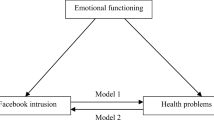Abstract
Use of online social networking sites such as Facebook has burgeoned in the last 5 years. We examine these sites as facilitators of Online Obsessive Relational Intrusion (o-ORI)—a much-talked about, but relatively un-researched online phenomenon. We draw parallels between the types of behaviors conducted online and those identified in the literature on relational intrusion and its more extreme relative, stalking. We present a frequency analysis of students’ behavior on Facebook and find evidence of relational intrusion from both offenders and targets. The behaviors can be classified into five different categories, including: primary contact attempts, secondary contact attempts (i.e., contacting others connected to the target), monitoring or surveillance, expressions, and invitations. We conclude that Facebook facilitates behaviors that are indicative of obsessive relational intrusion and that such behaviors have implications for users’ privacy and security.
Similar content being viewed by others
Notes
A full frequency report can be requested from the corresponding author.
Frequencies were compared using a z test of proportions with the hypothesis that the two proportions were equal (e.g., freq. (ex-intimate)-freq.(acquaintance) = 0).
References
Boyd, D. M., & Ellison, N. B. (2007). Social network sites: definition, history, and scholarship. Journal of Computer-Mediated Communication, 13(1), Article 11.
Caven, R. (2007). Face world: From talk to stalk. The Sunday Telegraph.
Dutton, L. B., & Winstead, B. A. (2006). Predicting unwanted pursuit: attachment, relationship satisfaction, relationship alternatives, and break-up distress. Journal of Social and Personal Relationships, 23(4), 565–586.
Ellison, N. B., Steinfield, C., & Lampe, C. (2007). The benefits of facebook “Friends:” Social capital and college students’ use of online social network sites. Journal of Computer-Mediated Communication, 12(4), Article 1.
George, A. (2006). Things you wouldn’t tell your mother. New Scientist, 191(2569), 50–51.
Govani, T., & Pashley, H. (2005). Student awareness of the privacy implications when using facebook. Unpublished Works.
Hargittal, E. (2008). Whose apace? Differences among users and non-users of social network sites. Journal of Computer-Mediated Communication, 13(1), 276–297.
Harkin, J. (2007). Here’s looking at us. If you’re been making friends with total strangers or stalking an old flame, the chances are you’ve been spending time on Facebook. James Harkin has been, too. Financial Times, p. 22.
Haugaard, J. J., & Seri, L. G. (2004). Stalking and other forms of intrusive contact among adolescents and young adults from the perspective of the person initiating the intrusive contact. Criminal Justice and Behavior, 31(1), 37–54.
Lampe, C., Ellison, N., & Steinfield, C. (2006). A face(book) in the crowd: Social searching vs. social browsing. Paper presented at the CSCW, Banff, Alberta, Canada.
Meloy, J. R. (2007). Stalking: the state of the science. Criminal Behaviour and Mental Health, 17, 1–7.
Nadkarni, R., & Grubin, D. (2000). Stalking: why do people do it? BMJ, 320, 1486–1487.
Ravensberg, V., & Miller, C. (2003). Stalking among young adults a review of the preliminary research. Aggression and Violent Behavior, 8, 455–469.
Sarno, D. (2007). You’re in site; MySpcae, Facebook allow us to snoop on friends and strangers. Seattle Times.
Sheridan, L., & Davies, G. M. (2001). Stalking: the elusive crime. Legal and Criminological Psychology, 6, 133–147.
Sinclair, H. C., & Frieze, I. H. (2005). When courtship persistence becomes intrusive pursuit: comparing rejector and prusuer perspectives of unrequited attraction. Sex Roles, 52(11/12), 839–852.
Skiba, D. J. (2007). Poke me. Where’s your face in space? Nursing Education Perspectives, pp. 214–216.
Sng, S. (2007). Psst... I’m a facestalker. Are you? Straits Times.
Spitzberg, B. H., & Cupach, W. R. (2003). What mad pursuit? Obsessive relational intrusion and stalking related phenomena. Aggression and Violent Behavior, 8, 345–375.
Spitzberg, B. H., & Cupach, W. R. (2006). The state of the art of stalking: taking stock of the emerging literature. Aggression and Violent Behavior, 12, 64–86.
Spitzberg, B. H., & Hoobler, G. (2002). Cyberstalking and the technologies of interpersonal terrorism. New Media & Society, 4(1), 71–92.
Spitzberg, B. H., & Rhea, J. (1999). Obsessive relational intrusion and sexual coercion victimization. Journal of Interpersonal Violence, 14(1), 3–20.
Tong, S. T., Van Der Heide, B., Langwell, L., & Walther, J. B. (2008). Too much of a good thing? The relationship between number of friends and interpersonal impressions on facebook. Journal of Computer-Mediated Communication, 13(3), 531–549.
Young, H. (2007). Facebook Facts. The Capitol Times & Winsconsin State Journal Retrieved January 15, 2008, 2008
Author information
Authors and Affiliations
Corresponding author
Appendix A
Appendix A
Rights and permissions
About this article
Cite this article
Chaulk, K., Jones, T. Online Obsessive Relational Intrusion: Further Concerns About Facebook. J Fam Viol 26, 245–254 (2011). https://doi.org/10.1007/s10896-011-9360-x
Published:
Issue Date:
DOI: https://doi.org/10.1007/s10896-011-9360-x




